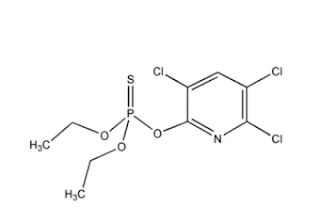 Pursuant to Prop 65 the Developmental and Reproductive Toxicity Identification Committee (DARTIC) under OEHHA made the decision to list chlorpyrifos under Proposition 65 as a developmental toxicant. Chlorpyrifos is one of the most widely-used active ingredients in agricultural insect control products in the world. It was first registered in the U.S. in 1965 and has been on the market for more than forty-five years. Products containing chlorpyrifos will have to be appropriately labeled by late 2018.
Pursuant to Prop 65 the Developmental and Reproductive Toxicity Identification Committee (DARTIC) under OEHHA made the decision to list chlorpyrifos under Proposition 65 as a developmental toxicant. Chlorpyrifos is one of the most widely-used active ingredients in agricultural insect control products in the world. It was first registered in the U.S. in 1965 and has been on the market for more than forty-five years. Products containing chlorpyrifos will have to be appropriately labeled by late 2018.
Chlorpyrifos was previously considered by the DARTIC in 2008, but was not added to the Proposition 65 list at that time. Substantial new data on developmental toxicity has become available since the chemical was previously considered for listing. Many groups have pushed to get chlorpyrifos off the market entirely. The Obama administration proposed an all-out ban in 2015. President Donald Trump’s appointed Environmental Protection Agency administrator Scott Pruitt ruled in spring 2017 that he would not ban the chemical.
Chlorpyrifos is an organophosphate insecticide. Pure chlorpyrifos is made up of white or colorless crystals. It has a slight odor. Chlorpyrifos is used to control many different kinds of pests, including termites, mosquitoes, and roundworms. Chlorpyrifos was first registered as an insecticide in 1965 and the United States Environmental Protection Agency (US EPA) re-registered it in 2006. The only legal indoor use for chlorpyrifos is in containers with treated baits.
The crops with the most use are cotton, corn, almonds and fruit trees including oranges, bananas and apples.
|
CROP
|
TARGET PESTS
|
|
Alfalfa
|
Alfalfa weevil,
armyworms, aphids, potato leafhoppers. |
|
Brassica Vegetables
(Cole Crops) (Broccoli, Cauliflower, Cabbage, Kale, Rutabaga, Turnips,
etc.) |
Cabbage maggot, aphids
|
|
Citrus
|
Scale insects,
mealybug, Asian citrus psyllid, rust mite, citrus leaf miner, katydids. |
|
Corn, Field
|
Corn rootworm,
cutworm, white grub, European corn borer |
|
Corn, Sweet
|
corn earworm,
armyworms, corn rootworm (larvae and adult), cutworms, seed corn maggot, wireworms |
|
Cotton
|
Cotton aphid, Lygus
bug, armyworms, pnk bollworm |
|
Grapes
|
Mealybugs, cutworms,
ants |
|
Mint
|
mint root borer
|
|
Onions
|
Onion maggot
|
|
Peanuts
|
Lesser cornstalk
borer, corn rootworms, white mold |
|
Pome Fruits
(Apples, Pears)
|
San Jose scale, rosy
apple aphid, pandemis leafroller, oblique-banded leafroller, climbing cutworms, American plum borer |
|
Soybeans
|
Soybean aphid, bean
leaf beetle, grasshoppers, spider mites |
|
Stone Fruits
(Peaches, Nectarines, Cherries, Plums)
|
San Jose scale, peach
twig borer, peaach twig borer, peach tree borer, lesser peach tree borer, American plum borer |
|
Sugar Beets
|
cutworm, wireworm,
sugarbeet root maggot, armyworms, grasshoppers |
|
Sweet Potatoes
|
Wireworms, southern
corn rootworm, flea beetles |
|
Tree nuts
(Almonds, Pecans, Walnuts, etc.)
|
San Jose scale, peach
twig borer, navel orangeworm, codling moth, walnut husk fly, walnut aphid, pecan nut casebearer, black pecan aphid |
|
Wheat
|
Aphids, grasshoppers,
orange wheatblossom midge |
The Office of Environmental Health Hazard Assessment (OEHHA) also has listed perfluorooctanoic acid (PFOA) and perfluorooctane sulfonate (PFOS) as reproductive toxicants under Proposition 65.
PFOA and PFOS are surfactants that have been used in a variety of consumer products, including carpets, textiles, leather, non-stick cookware, and paper coatings used in food packaging, to confer stain, grease and water resistance.
Manufacturing of PFOS was ended in 2002 and PFOA production ceased in 2015.
Craig A. Tristao is a Partner in the litigation and transactions departments of the firm’s Fresno office. He provides representation to clients in litigation matters involving agricultural law, environmental law, construction law, land use and natural resource law, water law, probate and estates, and eminent domain matters that involve the California High Speed Rail Authority. Craig also assists clients with regulatory compliance issues concerning the Clean Water Act (CWA), the Porter-Cologne Act, and the Clean Air Act (CAA). In addition to litigation, Craig also represents clients before the Regional Water Quality Control Boards and the State Water Resources Control Board, air districts, and the Contractors State License Board (CSLB). He has also been named a Super Lawyers “Rising Star” for 2015-2018 (2.5% of lawyers practicing under 10 years). You can contact Craig at (559) 248-4820 or ctristao@ch-law.com.

